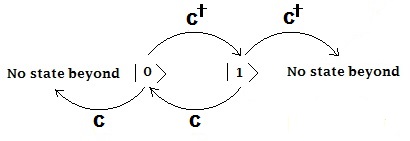Fock state
These states are named after the Soviet physicist Vladimir Fock.Fock states play an important role in the second quantization formulation of quantum mechanics.The particle representation was first treated in detail by Paul Dirac for bosons and by Pascual Jordan and Eugene Wigner for fermions.Additionally, depending on the integrality of the particles' spin, the tensor products must be alternating (anti-symmetric) or symmetric products of the underlying one-particle Hilbert spaces.Specifically: If the number of particles is variable, one constructs the Fock space as the direct sum of the tensor product Hilbert spaces for each particle number.In the Fock space, it is possible to specify the same state in a new notation, the occupancy number notation, by specifying the number of particles in each possible one-particle state.be an orthonormal basis of states in the underlying one-particle Hilbert space.This criterion nearly defines the Fock states (one must in addition select a phase factor).Elements of a Fock space that are superpositions of states of differing particle number (and thus not eigenstates of the number operator) are not Fock states.as the definition of Fock state ensures that the variance of measurement, i.e., measuring the number of particles in a Fock state always returns a definite value with no fluctuation.are arbitrary, we can say, Note that the number operator does not distinguish bosons from fermions; indeed, it just counts particles without regard to their symmetry type.We should be able to express the same symmetric property in this new Fock space representation.For this we introduce non-Hermitian bosonic creation and annihilation operators,[4] denoted byTherefore, it is clear that adjoint of creation (annihilation) operator doesn't go into itself.[5]: 45 The commutation relations of creation and annihilation operators in a bosonic system are whereThe commutation relations of the creation and annihilation operators ensure that the bosonic Fock states have the appropriate symmetric behaviour under particle exchange.The anticommutation relations of creation and annihilation operators in a fermionic system are, whereThese anticommutation relations can be used to show antisymmetric behaviour of Fermionic Fock states.The action of the number operator as well as the creation and annihilation operators might seem same as the bosonic ones, but the real twist comes from the maximum occupation number of each state in the fermionic Fock state.Hence, two identical fermions must not occupy the same state (a statement of the Pauli exclusion principle).Antisymmetric behaviour of Fermionic states under Exchange operator is taken care of the anticommutation relations.Therefore, in general, Fock states are not energy eigenstates of a system.These vacuum fluctuations are responsible for many interesting phenomenon including the Lamb shift in quantum optics.over all the modes: The creation and annihilation operators operate on the multi-mode state by only raising or lowering the number state of their own mode: We also define the total number operator for the field which is a sum of number operators of each mode: The multi-mode Fock state is an eigenvector of the total number operator whose eigenvalue is the total occupation number of all the modes In case of non-interacting particles, number operator and Hamiltonian commute with each other and hence multi-mode Fock states become eigenstates of the multi-mode Hamiltonian Single photons are routinely generated using single emitters (atoms, ions, molecules, Nitrogen-vacancy center,[8] Quantum dot[9]).However, these sources are not always very efficient, often presenting a low probability of actually getting a single photon on demand; and often complex and unsuitable out of a laboratory environment.Other sources are commonly used that overcome these issues at the expense of a nondeterministic behavior.Heralded single photon sources are probabilistic two-photon sources from whom the pair is split and the detection of one photon heralds the presence of the remaining one.These sources usually rely on the optical non-linearity of some materials like periodically poled Lithium niobate (Spontaneous parametric down-conversion), or silicon (spontaneous Four-wave mixing) for example.'th derivative of the Dirac delta function and therefore not a classical probability distribution.

quantum mechanicsquantum stateFock spaceparticlesquantaSovietVladimir Focksecond quantizationPaul DiracbosonsPascual JordanEugene Wignerfermionscreation and annihilation operatorstensor productsalternatingsymmetric productsHilbert spacesPauli exclusion principledirect sumparticle numberorthonormal basisparticle number operatorsuperpositionsvarianceoperatorindistinguishabilityexchange operatorHermitian operatorsbosonic systemcommutatorKronecker deltafermionic systemanticommutatorSlater determinantJordan–Wigner stringHamiltonian densityHamiltonianvacuum fluctuationsLamb shiftnumber operatorNitrogen-vacancy centerQuantum dotLithium niobateSpontaneous parametric down-conversionFour-wave mixingGlauber–Sudarshan P-representationDirac delta functionCoherent statesHeisenberg limitNonclassical light